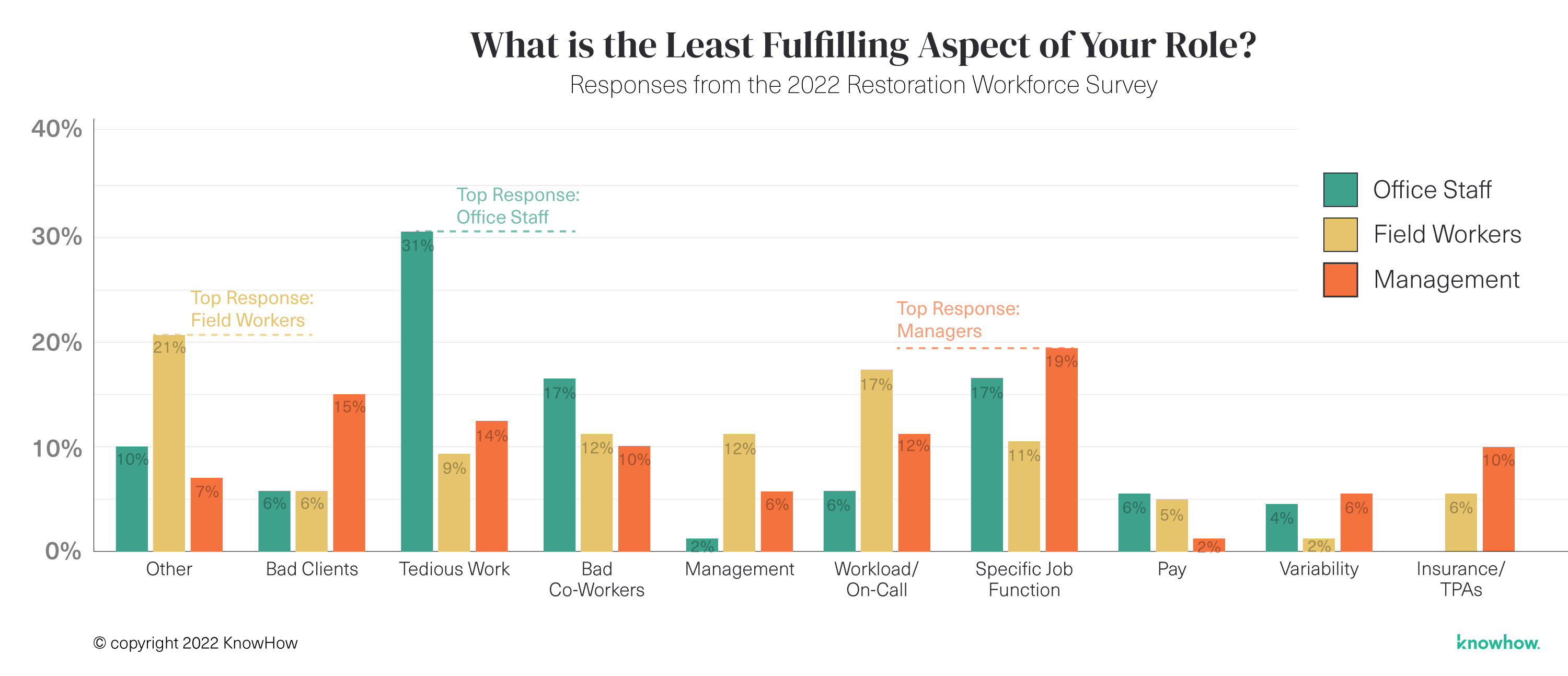
The Worst Parts About Working in Restoration, According to Restorers



Yes, you read that right. As one might guess, it’s not all friendly insurance adjusters and cleaning an already spotless home. Just like any job, there are ups and downs, things employees enjoy, and things they don’t.
So what?
Well, it’s critically important that senior leaders in the restoration industry what these factors are, because a surprisingly large number of them are avoidable. Today’s restoration workers have very little tolerance for self-inflicted wounds, and companies that needlessly make work more cumbersome for staff will find themselves with a permanent “Now Hiring” sign outside their office.
So what are the worst parts about working in restoration? The guessing can stop, the KnowHow team has answers.
KnowHow recently conducted the largest-ever survey on the restoration workforce, and we asked over 400 employees in the restoration industry across all job departments, seniority level, and age that very question. We wanted to find out the exact reasons why workers are quitting to provide restoration owners and managers with tangible ways they can make their workplace better.
Here are the top answers we received to the question “What is the Least Fulfilling Aspect of Your Role?”

Tedious Work
For office staff, tedious work came in as the top response for what the least fulfilling aspect of their role is. Specifically, 31% of restoration workers in an office related position, cited tedious work as the least fulfilling aspect of their job.
What does tedious work mean?
For the restoration industry, tedious work can be related to anything that feels redundant, repetitive, or work for the sake of working. For office staff, this could be related to piles and piles of paperwork, or work that just doesn’t seem to contribute in any way toward the company vision.
Work like this can be draining on an employee, especially if the work they’re doing doesn’t feel helpful, or doesn’t feel like it moves the needle in any way.
As one millennial estimator put it:
“The repetitiveness of this job can be very disheartening”.
This should be a giant red flag to leaders, who know the importance of connecting day-to-day tasks with the larger vision your company is trying to accomplish. How many of your staff members could articulate the mission your business is working towards? Is filing a report on DASH just another piece of tedious paperwork? Or is it a small piece in the larger puzzle that is being built in your business?If workers don’t understand the “why” behind many aspects of their role, don’t be surprised that more and more of them begin to complain about how monotonous their routine feels.
Bad Clients
It’s not a shock that this came up as one of the top responses to what the least fulfilling aspect of a job is. For managers, this was by far the top response, with 15% of respondents in a management position citing bad clients as the worst part of their job.
Managers deal with a lot in the day-to-day operations of a restoration business, but when crap hits the fan, managers are often the ones that need to cool the fire.
Yet here there lies another opportunity. When unruly customers begin to escalate a situation, do your staff know what to do? What framework does management use for negotiating or calming down clients?
If you haven’t established a clear set of guidelines and processes in this area, you are burdening your staff beyond what’s necessary. After all, you’ve essentially told them to figure it out on their own - a responsibility that likely was not in their job description, nor their skill set.
Management
Likewise, it’s not only a bad client that can spoil the bunch. Managers can have an even greater impact on an employee's passion for their job. If management has poor leadership skills, communication, or emotional control, it will affect the morale of all their direct reports, and will influence how long they see their tenure at the company.
In this category, 12% of respondents in front-line related positions agreed that management was the least fulfilling aspect of their job. How are you, as a senior leader in restoration, mitigating this? Are you investing into your management team?
As one fed up field-worker quotes:
“It’s frustrating dealing with poor leadership from upper management”.
Bad Co-Workers
One resounding source of frustration among all workers in the restoration industry was simply “team members letting me down”. When staff have not been properly trained and equipped with the information they need to excel in their role, it’s not only your customer that suffers. Day in and day out, your most talented workers are being brought down by those who were insufficiently trained.You can imagine some of the responses we received from field workers who were sick and tired of showing up to a job site without the right materials and information they needed to properly complete a job.
“When other team members don’t complete their tasks fully or are slow to bring something over the finish line, we all suffer”.
It’s management’s job to ensure that every team member has access to the knowledge and expertise they need to succeed in their role. After all, are team members dropping the ball because they’re lazy? Or do they have the desire to succeed, yet simply haven’t been taught how to do so?
Too Much on Their Plate
Finally, the top response for the least fulfilling aspect of a field workers’ role was simply having too much on their plate, coming in at 21%.
The restoration industry never sleeps. Field workers usually end up taking the brunt of that as they’re on-call a lot. Missing birthday parties, date nights, or big sporting events can be mentally exhausting over time if they start to add up over the years.
“I feel like they don’t realize how much I have on my plate because they just keep adding more to it”.
Many managers might counter this by saying “We’re constantly trying to hire new staff, but they keep quitting, making it worse for the workers who stay.” This is proof enough of the critical importance of keeping a close eye on how your workers are feeling, and seeking to eliminate avoidable frustrations when working in restoration.
For more tangible action items restoration businesses can take to make their workplace more attractive and increase employee retention, download and read our full e-book, “Why Workers Quit”.









